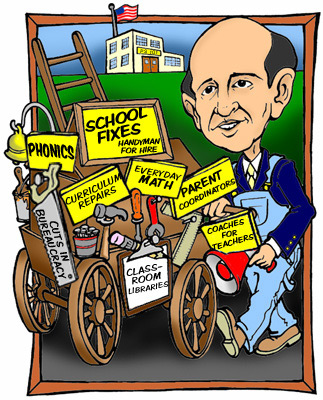 |
When school opened on September 8, class size in some elementary schools had increased 30 percent from last year's average of 25 students, Newsday reported. A number of middle schools have classes of 37 students compared to 32 in the 2002-2003 school year, and high schools are contending with nearly 1,000 more students than they had last year. In one high school in Queens, the Post found, 300 classes exceed union limits of 34 students per class, while another school in Manhattan has run out of space entirely, forcing 100 students to sit in the auditorium instead of classrooms. According to the UFT, more than 9,000 classes now violate union contractual limits on size. About the only grade level where classes have not increased in size is pre-kindergarten, since state law strictly limits those classes to 18 children per teacher.
Study after study has shown that smaller classes lead to higher grades and test scores, particularly for poor and minority students, as well as more parental involvement, fewer disciplinary problems and lower dropout rates. In their recent ruling that the state school aid formula for New York City illegally deprives city students of a sound basic education (in pdf format), judges on the state's highest court cited the city's oversized classes as key evidence that the state was providing our children with an inadequate education.
Overcrowding in city schools has endured for decades and through many administrations. Though Mayor Michael Bloomberg has acknowledged the importance of class size and promised to speed school construction and expansion, he has reduced the capital budget for schools by over $3 billion, a cut of 53 percent, according to the Independent Budget Office (in pdf format). And Chancellor Joel Klein has apparently forgotten his pledge not to allow other class sizes to increase.
Whether this fall's deterioration is due to poor management, misplaced priorities, budget cuts, a misguided interpretation of the federal No Child Left Behind law, or because students are being forced out of some larger high schools that are being broken up into new smaller high schools, it is clearer than ever before that we must address this critical problem.
Recently, a coalition was created called New Yorkers for Smaller Classes. It is composed of advocacy organizations, unions, and parent groups. On August 18, the coalition presented the city clerk with petitions signed by more than 115,000 registered voters who support the creation of a new City Charter Revision Commission that would consider limiting class size in all grades. This is more than twice the number of signatures needed to put this question on the ballot in November.
Once the charter commission is up and running, it would decide whether a proposition to limit class sizes should be put before the voters in November 2004. Members of the commission would have many other important issues to debate and consider, including what specific class sizes might be proposed and how smaller classes could be funded. Clearly it will be costly to build classrooms and to hire the additional teachers needed for smaller classes. But it would be worth it.
As Assemblymember Steve Sanders pointed out when we presented our signed petitions to the city clerk, because of the state court's decision that our schools provide an inadequate education, billions of dollars in additional state education aid are expected to flow to New York City. Moreover, economists estimate that the benefits of smaller classes are twice as great as the costs, in terms of the future earnings of high school graduates alone. Oversize classes damage the city's competitiveness, by hurting our ability to provide an educated work force. They also spur families to move to the suburbs when they have children. A recent report from the Center for an Urban Future (in pdf format) points out that the most profitable economic development the city could embark upon would be to invest in improving basic services like education, in order to "build [our] middle class and keep people in the city."
Pre-school and reducing class size are the only educational reforms that have been proven to substantially reduce the achievement gap between rich and poor, and between white and minority students. We need a city charter commission to come up with a realistic plan to limit class size for the sake of our children as well as the economic future of this city. Then, let the voters decide.
Leonie Haimson is a parent, education advocate, amd chair of Class Size Matters, an organization dedicated to achieving smaller classes in NYC public schools and a member of the New Yorkers for Smaller Classes coalition.
Related Article
School Reforms of 2003
School opened last week with a new bureaucracy, 1,200 new "parent coordinators," teaching coaches and a new standard curriculum. Will any of this fix the system?




